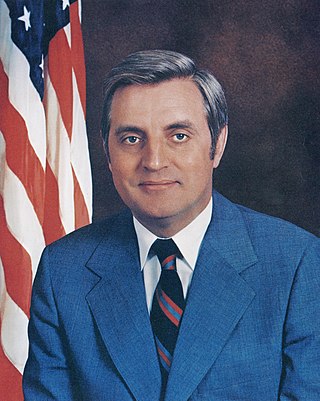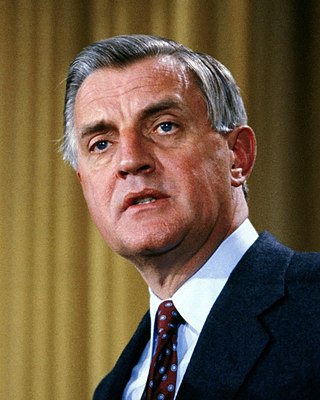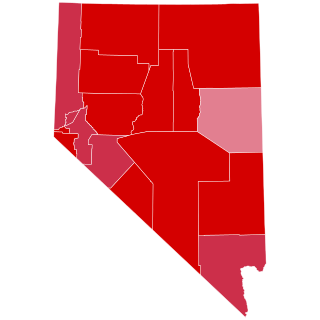
The 1980 United States presidential election was the 49th quadrennial presidential election, held on Tuesday, November 4, 1980. The Republican ticket of Ronald Reagan and George H. W. Bush defeated incumbent Democratic president Jimmy Carter and incumbent vice president Walter Mondale in a landslide victory.

The 1984 United States presidential election was the 50th quadrennial presidential election held on Tuesday, November 6, 1984. Incumbent Republican president Ronald Reagan defeated Democratic former vice president Walter Mondale in a landslide victory.

Walter Frederick "Fritz" Mondale was an American lawyer and politician who served as the 42nd vice president of the United States from 1977 to 1981 under President Jimmy Carter. A U.S. senator from Minnesota from 1964 to 1976, he was the Democratic Party's nominee in the 1984 presidential election, but lost to incumbent Ronald Reagan in an Electoral College and popular vote landslide.

Barbara Joan "Barbra" Streisand is an American singer, actress, and director. With a career spanning over six decades, she has achieved success in multiple fields of entertainment and is among the few performers awarded an Emmy, Grammy, Oscar, and Tony (EGOT).

Geraldine Anne Ferraro was an American politician, diplomat, and attorney. She served in the United States House of Representatives from 1979 to 1985, and was the Democratic Party's vice presidential nominee in the 1984 presidential election, running alongside Walter Mondale; this made her the first female vice-presidential nominee representing a major American political party. She was also a journalist, author, and businesswoman.
In American politics, a superdelegate is a delegate to a presidential nominating convention who is seated automatically.

From February 20 to June 12, 1984, voters of the Democratic Party chose its nominee for president in the 1984 United States presidential election. Former Vice President Walter Mondale was selected as the nominee through a series of primary elections and caucuses culminating in the 1984 Democratic National Convention held from July 16 to July 19, 1984, in San Francisco, California.

The 1984 United States elections was held on November 6, and elected the members of the 99th United States Congress. Republicans won a landslide victory in the presidential election, picked up seats in the House of Representatives, and successfully defended their Senate majority.

The 1984 United States presidential election in Nevada took place on November 6, 1984. All 50 states and the District of Columbia, were part of the 1984 United States presidential election. State voters chose four electors to the Electoral College, which selected the president and vice president of the United States.

The 1984 United States presidential election in South Dakota took place on November 6, 1984. All 50 states and the District of Columbia, were part of the 1984 United States presidential election. Voters chose three electors to the Electoral College, which selected the president and vice president of the United States.

The 1984 United States presidential election in Nebraska took place on November 6, 1984. All 50 states and the District of Columbia, were part of the 1984 United States presidential election. Voters chose five electors to the Electoral College, which selected the president and vice president of the United States.

The 1984 United States presidential election in Iowa took place on November 6, 1984. All 50 states and the District of Columbia, were part of the 1984 United States presidential election. Voters chose eight electors to the Electoral College, which selected the president and vice president of the United States.

The 1984 United States presidential election in Louisiana took place on November 6, 1984. All 50 states and the District of Columbia, were part of the 1984 United States presidential election. State voters chose ten electors to the Electoral College, which selected the president and vice president of the United States. Louisiana was won by incumbent United States President Ronald Reagan of California, who was running against former Vice President Walter Mondale of Minnesota. Reagan ran for a second time with former C.I.A. Director George H. W. Bush of Texas, and Mondale ran with Representative Geraldine Ferraro of New York, the first major female candidate for the vice presidency.

The 1984 United States presidential election in Wisconsin took place on November 6, 1984. All 50 states and the District of Columbia, were part of the 1984 United States presidential election. State voters chose 11 electors to the Electoral College, which selected the president and vice president of the United States.

The 1984 United States presidential election in Illinois took place on November 6, 1984. All 50 states and the District of Columbia, were part of the 1984 United States presidential election. State voters chose 24 electors to the Electoral College, which selected the president and vice president of the United States.

This article lists those who were potential candidates for the Democratic nomination for vice president of the United States in the 1984 election. Former Vice President Walter Mondale won the 1984 Democratic nomination for president of the United States, and chose New York Representative Geraldine Ferraro as his running mate. Ferraro was the first woman to be a part of a national ticket for a major party. Mondale chose Ferraro in hopes of energizing the base and winning the votes of women, but also because he viewed her as a solid legislator who had won the approval of Speaker Tip O'Neill. John R. Reilly, an attorney and a senior adviser to Mondale, managed the search for a running mate. Mondale seriously considered his major rival for the 1984 presidential nomination, Senator Gary Hart, but Mondale refused to consider a second rival, Jesse Jackson, on the grounds that the differences between their policies were too great. The Mondale–Ferraro ticket ultimately lost to the Reagan–Bush ticket. This is the last time the Democratic vice presidential nominee was not the incumbent vice president or a senator, and, not counting the times when the incumbent president was running for re-election, the last time the Democratic vice presidential nominee was not a senator.

The Walter Mondale 1984 presidential campaign began on February 21, 1983, when Walter Mondale, a former Minnesota senator and vice president of the United States, announced that he was running for president in a speech at the Minnesota State Capitol. Mondale won the Democratic Party's presidential nomination after convincing Frank Lautenberg, a previously unpledged party delegate, to support him. Lautenberg's vote gave Mondale the 1,967 delegate votes needed to become the Democratic Party's nominee. Mondale picked Geraldine Ferraro, a U.S. representative from New York, as his running mate. Mondale lost the general election, held on November 6, 1984, to incumbent Republican President Ronald Reagan in a landslide. Had Mondale been elected, he would have been the first U.S. president from Minnesota and the first non-incumbent vice president since Richard Nixon to take office as president. Ferraro would also have been the country's first female vice president, and the first person from New York since Nelson Rockefeller to become vice president, whereas her husband, John Zaccaro, would also have been the country's first second gentleman.
The 1984 United States presidential election debates were held during the 1984 presidential election. Three debates were held between Republican candidate, incumbent president Ronald Reagan and former Democratic vice president Walter Mondale under Jimmy Carter, the major candidates. One debate was held with their vice presidential running mates, incumbent vice president George H. W. Bush and congresswoman Geraldine Ferraro.
The "Malibu Mafia" was an informal group of wealthy American Jewish men who donated money to liberal and progressive causes and politicians during 1960s–1990s. Associated with the beach city of Malibu, California, the group included economist Stanley Sheinbaum, Warner Bros. chairman Ted Ashley, television producer Norman Lear, and four businessmen: Harold Willens, Leopold Wyler, Miles L. Rubin and Max Palevsky. Founded in opposition to the Vietnam War, the group often met at Willens' beachfront house on Malibu Colony Road, and also in Sheinbaum's home in Westwood, Los Angeles, where he held a regular political salon with liberal participants, especially from the film and television industries of Greater Los Angeles. The Malibu Mafia were known for funding the failed George McGovern 1972 presidential campaign, the legal defense of Pentagon Papers whistleblower Daniel Ellsberg, the successful 1973 campaign by African-American politician Tom Bradley to become the mayor of Los Angeles, the 1978 salvaging of the progressive magazine The Nation, the Nuclear Freeze campaign of the 1980s, and the Israel–Palestine negotiations that yielded the Oslo Accords in 1993.

















